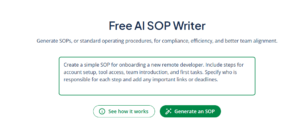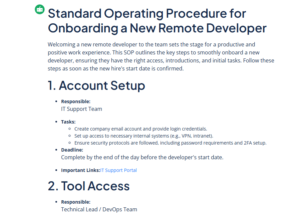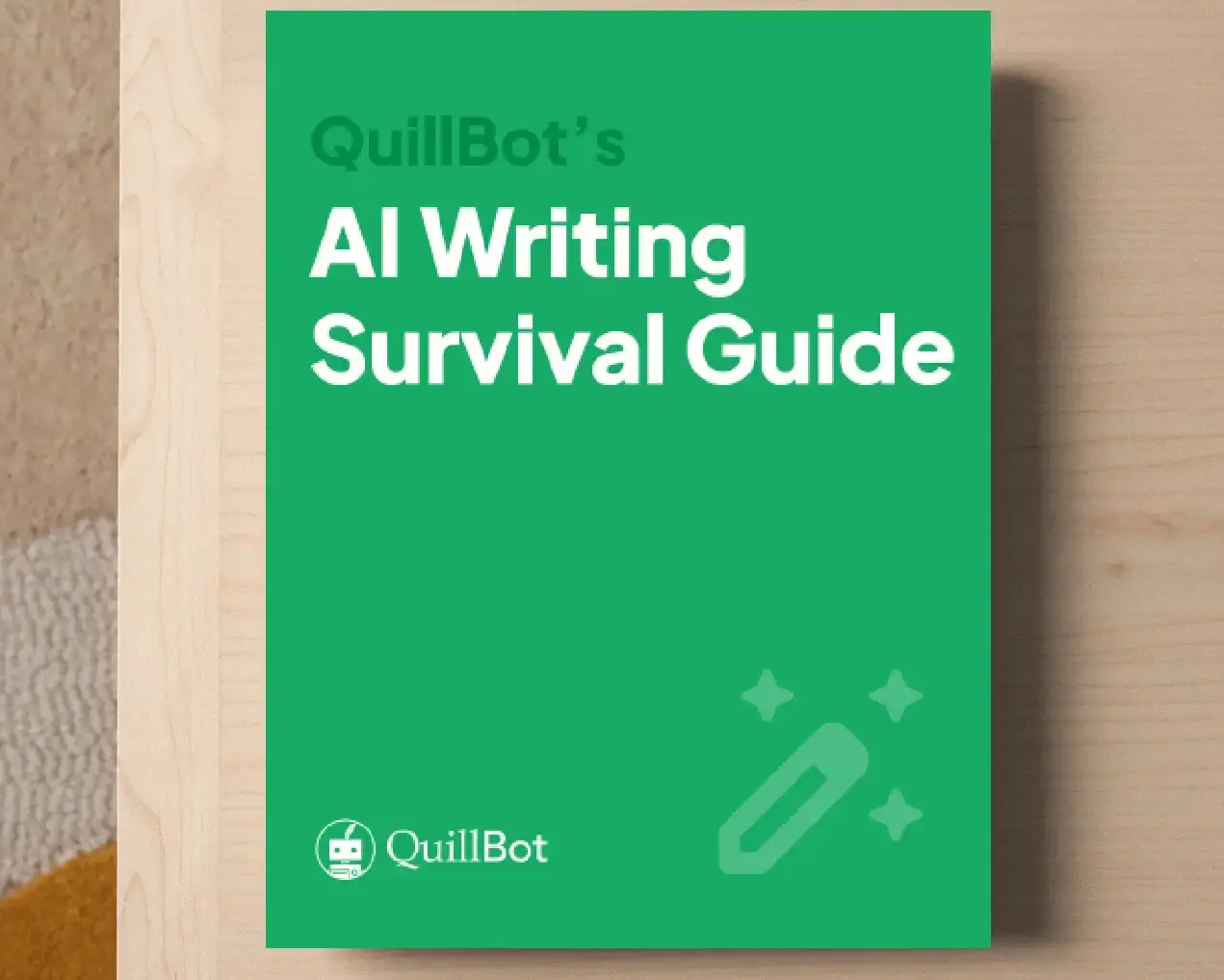What Is an SOP? | Examples & Writing Guide
You sit down for your first day as a junior developer at a remote startup. You open your laptop, but your excitement quickly curdles into confusion. No welcome email, no setup guide—just a jumble of Slack channels with names like #random-thoughts and #meme-central.
Your first task arrives with no explanation, no access to the company’s codebase (all the software files you need to work on), and cryptic acronyms you’ve never seen. Meeting invites pop up across different time zones, colliding with your attempts to figure out the system. You try asking questions in the general chat, but your messages are either ignored by colleagues juggling their own chaos or met with dismissive “check the docs” replies—docs that either don’t exist or are buried in some unmarked Google Drive folder. By midday, you’re lost in half-explained processes, invisible team conventions, and scattered documentation.
All of this could have been avoided with a clear SOP (or standard operating procedure): a step-by-step onboarding guide that explains communication channels, workflow expectations, and task responsibilities from day one. If you want to find out more about what an SOP is, check out real SOP examples, and see how to write an SOP quickly using QuillBot’s AI SOP writer, keep reading.
Table of contents
SOP meaning
A Standard Operating Procedure (SOP) is a written set of instructions that explains how to complete a task or process so that it’s done consistently each time. SOPs can be text documents, step-by-step checklists, flowcharts, or even videos—whatever format makes the process easiest to follow.
Organizations use SOPs in a wide range of contexts, and understanding SOP meaning in business goes beyond onboarding:
- Healthcare: For tasks like giving medication or sterilizing equipment, SOPs help staff follow safety rules, and meet regulations.
- Manufacturing: SOPs guide machine operation or quality checks so products stay consistent and errors are reduced.
Customer service: They show how to handle complaints or process refunds, ensuring every customer gets the same level of care. - Software development: They outline code reviews or deployment steps, keeping teams aligned across projects and time zones.
- Hospitality: They define cleaning routines or guest check-in steps to keep service smooth and compliant with health standards.
No matter the industry, SOPs give teams a reliable reference so work stays consistent, efficient, and compliant with standards.
How to write an SOP
Follow these basic steps to create a clear and effective SOP:
1. Define the purpose
Explain why the SOP is needed and what it will achieve. For example, a localization team might create an SOP to standardize how new content is translated and reviewed
2. Identify the steps
Break the process into simple, sequential actions and use short, clear sentences. Provide enough detail so that anyone on the team can complete the tasks safely and correctly.
3. Assign responsibilities
Clarify who is responsible for each step. In a localization project, one person might handle translations while another reviews quality.
4. Review and test
Get feedback from those who will use it to identify any gaps or unclear instructions. Update steps if anything is confusing.
Purpose:
Ensure all new website content is accurately translated and reviewed before publishing, maintaining quality and consistency.
Steps:
- Content Assignment
- The content manager assigns new articles to a translator in the project management tool.
- Deadline for translation is set in the tool.
- Translation
-
- The translator completes the translation using the approved style guide.
- Notes any uncertainties or context questions in a shared comment section.
- Review
- A designated reviewer checks the translation for accuracy, tone, and consistency.
- The reviewer adds comments or approves the translation in the shared document.
- Final Approval and Publishing
-
- Project lead confirms all revisions are applied.
- Content is published on the website and archived for future reference.
Responsibilities:
- Content Manager: Assigns tasks and sets deadlines
- Translator: Completes translation following the style guide
- Reviewer: Checks accuracy and consistency
- Project Lead: Approves final content
Pro Tip: Include links to style guides, translation software, and project folders to make the SOP easy to follow.
Using an AI SOP generator
Even with a clear outline, writing an SOP can feel overwhelming: steps, roles, and important details are often scattered across emails and notes. QuillBot’s AI SOP writer brings everything together in a clear, organized format: you feed in what you already know about the process, and within minutes, you have a complete draft ready to use.
Here’s how you can create an SOP for any process with QuillBot’s AI SOP writer:
1. Enter your idea
Type a clear, detailed prompt into the chatbox describing the process, including the main steps and any roles involved, then press enter. For example, this is how you can prompt the tool to create an SOP for onboarding a new remote developer:
The tool would give you something like this:
2. Tweak your results
Adjust the wording, tone, or steps until the SOP matches your workflow and requirements. For example, you may want to make it more comprehensive and prompt the tool to include first-week guidance.
3. Get your SOP
Copy your finished SOP and share it with your team. Don’t forget to review it with anyone directly involved before putting it into use.
- What does SOP stand for?
-
SOP stands for Standard Operating Procedure. It’s a set of written instructions that explain how to complete a task or process the same way every time. Businesses, government departments, and NGOs use SOPs to keep work consistent, efficient, and compliant.
Need an SOP quickly? Use QuillBot’s AI SOP writer to create one in minutes.
- Who writes SOPs in a company?
-
Standard Operating Procedures are typically written by the people who know the process best, such as operations managers, subject matter experts (SMEs), or process engineers. In many organizations, SOPs are part of the technical writing process, which turns complex steps into clear, user-friendly instructions. Larger companies may also involve cross-functional teams or external consultants to ensure accuracy and consistency.
Tools like QuillBot’s AI SOP writer help streamline this process for your team. You gather input from those performing the task, supervisors, or quality officers, and the tool turns it into a clear SOP that your team can easily follow.
- What is an SOP in business?
-
In business, a Standard Operating Procedure (SOP) is a document outlining the steps required to complete a task. SOPs help teams maintain quality, follow regulations, and reduce errors by making sure everyone carries out routine tasks or operations consistently. SOPs can cover anything from customer service workflows to manufacturing steps or software deployment procedures.
If you want to turn these kinds of business processes into a clear, ready-to-follow SOP, QuillBot’s AI SOP Writer can help you draft one quickly.
Cite this Quillbot article
We encourage the use of reliable sources in all types of writing. You can copy and paste the citation or click the "Cite this article" button to automatically add it to our free Citation Generator.
QuillBot. (2025, September 18). What Is an SOP? | Examples & Writing Guide. Quillbot. Retrieved December 25, 2025, from https://quillbot.com/blog/ai-writing-tools/what-is-an-sop-examples-writing-guide/



